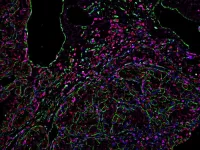(Press-News.org) The synovial tissue inflammation seen in RA shows high degree of heterogeneity – which may be a factor in people’s variable response to treatments. We also know that distinct synovial tissue macrophage subsets regulate inflammation and remission in rheumatoid arthritis.1 The potential of high-throughput analyses has been shown, and these technologies can help dissect disease heterogeneity and identify novel biomarkers that could be used in prognosis.2
To explore this further, 373 treatment-naïve RA patients were enrolled and given an ultrasound-guided synovial tissue biopsy. The synovitis degree and synovial pathotype was then determined for each individual. A subset of 45 samples was used for synovial tissue macrophage phenotyping and profiling in order to measure the abundance of distinct macrophage populations. Moreover, the transcriptomic profile of CD68pos cells in distinct regions of interest within the synovial tissue was determined using spatial technology. After study entry, patients were managed with a treat-to-target strategy.
The findings showed that those patients who reached disease remission at 6 months had lower Krenn Synovitis Score (KSS) at baseline compared to people who did not achieve this outcome. People who had been stratified based on synovial pathotype as lympho-myeloid or diffuse-myeloid pathotype had a lower response to conventional synthetic disease-modifying antirheumatic drugs (csDMARD) compared to people with a pauci-immune pathotype. However, further analysis suggested that, at an individual level, baseline KSS has limited capacity to distinguish between responders and non-responders, which highlights the need for multi-modal tissue deconvolution.
Flow cytometry analysis revealed that those with lympho-myeloid or diffuse-myeloid pathotypes showed comparable enrichment of two distinct synovial tissue macrophage populations (MerTKposCD206pos and MerTKnegCD206neg), while patients with the pauci-immune pathotype showed a predominance of MerTKposCD206pos. The enrichment of MerTKposCD206pos synovial tissue macrophages was also higher in people who achieved remission at 6 months. Notably, enrichment of these MerTKpos synovial tissue macrophages greater than 44.3% from baseline was shown to be an independent factor associated with achieving remission at 6 months.
Digital spatial profiling of synovial tissue biopsies revealed differential gene networks activating the macrophages in distinct tissue locations. This method was also able to identify transcriptomic signatures of synovial tissue macrophages in the lining and sublining location that were associated with response to csDMARD. Integration of sequencing and transcriptomic data resulted in the group being able to map synovial tissue macrophages clusters and stratify them based on treatment response.
Such multi-modal analysis of synovitis could enable differentiation of treatment-naïve RA patients at their first medical evaluation, and the data strongly support the predictive value as a patient-based decision test tool.
Source
Alivernini S, et al. Multi-modal analysis of synovial tissue macrophages informs on treatment response in naive to treatment Rheumatoid Arthritis. Presented at EULAR 2024; OP0062.
Ann Rheum Dis 2024; DOI: 10.1136/annrheumdis-2024-eular.2383.
References
1. Alivernini S, et al. Inclusion of Synovial Tissue-Derived Characteristics in a Nomogram for the Prediction of Treatment Response in Treatment-Naive Rheumatoid Arthritis Patients. Arthritis Rheumatol 2021;73(9):1601–13.
2. Alivernini S, et al. Distinct synovial tissue macrophage subsets regulate inflammation and remission in rheumatoid arthritis. Nat Med 2020;26(8):1295–306.
About EULAR
EULAR is the European umbrella organisation representing scientific societies, health professional associations and organisations for people with rheumatic and musculoskeletal diseases (RMDs). EULAR aims to reduce the impact of RMDs on individuals and society, as well as improve RMD treatments, prevention, and rehabilitation. To this end, EULAR fosters excellence in rheumatology education and research, promotes the translation of research advances into daily care, and advocates for the recognition of the needs of those living with RMDs by EU institutions.
Contact
EULAR Communications, communications@eular.org
Notes to Editors
EULAR Recommendations
EULAR School of Rheumatology
EULAR Press Releases
END
Predicting response in treatment-naïve RA
Harnessing the power of multi-modal analysis
2024-06-12
ELSE PRESS RELEASES FROM THIS DATE:
Testing the systemic score for Still’s disease
2024-06-12
A multi-centre, observational, prospective study was designed to evaluate the clinical usefulness of the systemic score in predicting life-threatening evolution – defined as the development of macrophage activation syndrome (MAS) and/or mortality. The intention was also to derive a more aggressive clinical patient subset. To achieve this, Ruscitti and colleagues collected data from 597 patients taking part in the GIRRCS (Gruppo Italiano Di Ricerca in Reumatologia Clinica e Sperimentale) AOSD-study ...
Early RA: Disease trajectories and pain
2024-06-12
The 2024 EULAR congress in Vienna included a clinical abstract session focusing on pain and prognosis in RA, where two groups presented their research into ways to characterise early RA.
The first looked at dissecting early RA patient trajectories through time-independent disease state patterns of inflammation in blood or joints. Presenting the work, Nils Steinz said “Previous studies have identified smooth time trajectories of rapid, slow, or no progression of disease activity, assessed through DAS28. In real life, we observe more chaotic disease evolvements – and particularly the detours could ...
Testing the thresholds
2024-06-12
However, this recommendation is not always followed in practice. This could be because the ASDAS was developed for research, and it is not known how well it performs in daily practice. Possibly, the cut-off of 2.1 as currently endorsed may be too strict in an everyday setting. To address this, Webers and colleagues set out to investigate which ASDAS cut-off values correspond best with treatment intensification in practice.
Data were taken from a prospective multi-centre registry for SpA, and treatment ...
Ingestible microbiome sampling pill technology advances
2024-06-12
Significant progress has been made at Tufts University School of Engineering in the development of a small device, about the size of a vitamin pill, that can be swallowed and passed through the gastrointestinal tract to sample the full inventory of microorganisms in an individual’s gastro-intestinal tract. This device has the potential to advance research on the relationship between resident bacteria and a wide range of health conditions. It could also serve as a diagnostic tool for adjusting the microbiome or administering drugs to treat those conditions.
The device has completed ...
Just thinking about a location activates mental maps in the brain
2024-06-12
As you travel your usual route to work or the grocery store, your brain engages cognitive maps stored in your hippocampus and entorhinal cortex. These maps store information about paths you have taken and locations you have been to before, so you can navigate whenever you go there.
New research from MIT has found that such mental maps also are created and activated when you merely think about sequences of experiences, in the absence of any physical movement or sensory input. In an animal study, the researchers found that the entorhinal cortex harbors a cognitive map of what animals experience while they use a joystick to browse through a sequence of images. ...
Obesity-cancer connection discovery suggests strategies for improving immunotherapy
2024-06-12
Immune system cells called macrophages play an unexpected role in the complicated connection between obesity and cancer, a Vanderbilt University Medical Center-led research team has discovered.
Obesity increases the frequency of macrophages in tumors and induces their expression of the immune checkpoint protein PD-1 — a target of cancer immunotherapies. The findings, published June 12 in the journal Nature, provide a mechanistic explanation for how obesity can contribute to both increased cancer ...
Smartwatches offer window into Parkinson's disease progression
2024-06-12
Ubiquitous wearable technologies, like smartwatches, could help researchers better understand progressive neurological disorders like Parkinson’s disease and speed up the approval of new therapies, a critical need given that no drugs exist to slow progression of the world’s fastest growing brain disease.
New research appearing today in the journal njp Parkinson’s Disease adds to growing evidence that widely used and user-friendly consumer devices, in this instance an Apple Watch paired with an iPhone, ...
What the geologic record reveals about how oceans were oxygenated 2.3 billion years ago
2024-06-12
About 2.5 billion years ago, free oxygen, or O2, first started to accumulate to meaningful levels in Earth’s atmosphere, setting the stage for the rise of complex life on our evolving planet.
Scientists refers to this phenomenon as the Great Oxidation Event, or GOE for short. But the initial accumulation of O2 on Earth was not nearly as straightforward as that moniker suggests, according to new research led by a University of Utah geochemist.
This “event” lasted at least 200 million years. And tracking the accumulation of O2 in the oceans has been very difficult until now, ...
Incidence of dementia before age 65 years among World Trade Center attack responders
2024-06-12
About The Study: In this cohort study of World Trade Center responders who survived these unique exposures and participated in a longitudinal follow-up study of cognition from 2014 through 2022, when compared with responders with the lowest exposure levels or responders who used personalized protective equipment (PPE), more severe exposure to dust or debris was significantly associated with a higher risk of dementia before 65 years of age. This study suggests that the reliable use of PPE might help prevent the onset of dementia before age 65 years among individuals exposed to an uncontrolled building collapse. Future ...
Neighborhood deprivation and breast cancer mortality among Black and white women
2024-06-12
About The Study: Neighborhood deprivation was associated with increased breast cancer mortality among non-Hispanic white women in this cohort study. Neighborhood racial composition, residential mobility, and rurality did not explain the lack of association among non-Hispanic Black women, suggesting that factors beyond those explored here may contribute to breast cancer mortality in this racial group.
Corresponding Author: To contact the corresponding author, Lauren E. Barber, Ph.D., email lauren.barber@emory.edu.
To access the embargoed study: Visit our For The Media website at this link https://media.jamanetwork.com/
(doi:10.1001/jamanetworkopen.2024.16499)
Editor’s ...
LAST 30 PRESS RELEASES:
The Ceramic Society of Japan’s Oxoate Ceramics Research Association launches new international book project
Heart-brain connection: international study reveals the role of the vagus nerve in keeping the heart young
Researchers identify Rb1 as a predictive biomarker for a new therapeutic strategy in some breast cancers
Survey reveals ethical gaps slowing AI adoption in pediatric surgery
Stimulant ADHD medications work differently than thought
AI overestimates how smart people are, according to HSE economists
HSE researchers create genome-wide map of quadruplexes
Scientists boost cell "powerhouses" to burn more calories
Automatic label checking: The missing step in making reliable medical AI
Low daily alcohol intake linked to 50% heightened mouth cancer risk in India
American Meteorological Society announces Rick Spinrad as 2026 President-Elect
Biomass-based carbon capture spotlighted in newly released global climate webinar recording
Illuminating invisible nano pollutants: advanced bioimaging tracks the full journey of emerging nanoscale contaminants in living systems
How does age affect recovery from spinal cord injury?
Novel AI tool offers prognosis for patients with head and neck cancer
Fathers’ microplastic exposure tied to their children’s metabolic problems
Research validates laboratory model for studying high-grade serous ovarian cancer
SIR 2026 delivers transformative breakthroughs in minimally invasive medicine to improve patient care
Stem Cell Reports most downloaded papers of 2025 highlight the breadth and impact of stem cell research
Oxford-led study estimates NHS spends around 3% of its primary and secondary care budget on the health impacts of heat and cold in England
A researcher’s long quest leads to a smart composite breakthrough
Urban wild bees act as “microbial sensors” of city health.
New study finds where you live affects recovery after a hip fracture
Forecasting the impact of fully automated vehicle adoption on US road traffic injuries
Alcohol-related hospitalizations from 2016 to 2022
Semaglutide and hospitalizations in patients with obesity and established cardiovascular disease
Researchers ‘listen in’ to embryo-mother interactions during implantation using a culture system replicating the womb lining
How changing your diet could help save the world
How to make AI truly scalable and reliable for real-time traffic assignment?
Beyond fragmented markets: A new framework for efficient and stable ride-pooling
[Press-News.org] Predicting response in treatment-naïve RAHarnessing the power of multi-modal analysis


